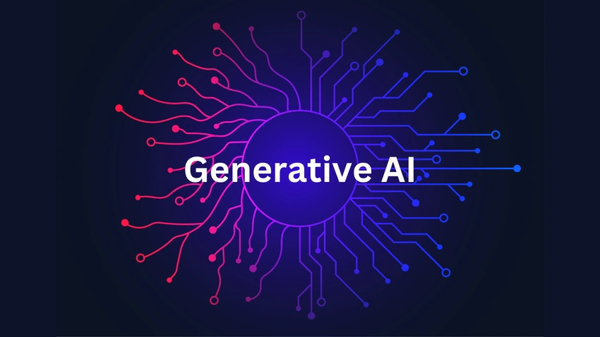
Generative AI is a branch of artificial intelligence that focuses on creating new content, such as images, text, audio, or video, based on existing data. Unlike traditional AI systems that are primarily designed to recognize patterns or make decisions, generative AI models have the capability to produce novel data that mimics human creativity. The technology behind generative AI leverages advanced machine learning techniques, particularly deep learning and neural networks, to learn from massive datasets and generate new, highly realistic outputs.
How Does Generative AI Work?
Generative AI models typically work using two types of networks: Generative Adversarial Networks (GANs) and Transformer-based models.
Generative Adversarial Networks (GANs): These are composed of two neural networks, a generator, and a discriminator. The generator tries to create realistic data, while the discriminator evaluates its authenticity. Over time, this adversarial process helps the generator produce increasingly realistic outputs.
Example: GANs are often used in art generation. Artists can use GAN-based models to generate realistic images of non-existent places or objects by feeding the model large amounts of training data. This technology has been applied in industries such as fashion and interior design to create prototypes and concept images.
Step-by-step solution:
- Step 1: The generator creates random images.
- Step 2: The discriminator evaluates the images and determines whether they are real or fake.
- Step 3: The feedback is used by the generator to improve its next set of images.
- Step 4: This process continues until the generated images become indistinguishable from real ones.
Transformer-based Models: These models, like GPT (Generative Pre-trained Transformers), focus on generating language-based content such as text, code, or dialogue. Transformer models use an attention mechanism to understand relationships between words or tokens in a sentence and can generate coherent responses, summaries, or even entire essays based on given input.
Example: GPT models are widely used in natural language processing tasks such as chatbot development, content generation, or summarization. These models have been employed by businesses to automate customer support or generate reports in real-time.
Step-by-step solution:
- Step 1: The model is trained on vast amounts of text data.
- Step 2: A user inputs a prompt or text.
- Step 3: The model generates a response by predicting the most likely sequence of words based on the context provided.
- Step 4: The output can then be refined or tailored to suit specific needs, like writing articles, poems, or emails.
Real-Life Applications of Generative AI
Generative AI is increasingly being integrated into real-life applications, transforming industries such as entertainment, healthcare, and finance.
Content Creation:
- Blog Writing: Tools like GPT-4 are being used to generate blog posts, news articles, and creative content at scale. For example, marketing firms can automate content creation, allowing teams to focus on strategy and editing.
Example: A digital marketer might input keywords related to their business into a generative AI model, which then produces a blog post tailored to the audience. This can save time and effort, especially in industries where frequent content updates are necessary.
Art and Design:
- AI-generated Art: Platforms like DALL·E (based on GPT-3) allow users to create original art by inputting text descriptions. For example, you can input "a futuristic cityscape with flying cars," and the AI will generate a series of images matching that description.
Example: In graphic design, companies can use AI to prototype products or create unique design concepts that inspire human designers.
Healthcare:
- Drug Discovery: Generative models are used to simulate molecular structures and generate new compounds that could be used in medicine. These models help pharmaceutical companies accelerate drug discovery and predict how different compounds might interact.
Example: AI can generate thousands of new molecules based on a dataset of known drugs, and researchers can then test the most promising candidates in the lab, saving years of trial and error.
Gaming and Virtual Reality:
- Procedural Content Generation: In video games, generative AI can be used to create vast, complex worlds and environments autonomously. Games like Minecraft and No Man's Sky leverage algorithms to generate unique landscapes and objects, offering players a virtually endless exploration experience.
Example: Game developers use generative AI to create random missions, levels, or characters, ensuring a unique experience for each player.
Music and Film:
- AI-Composed Music: Tools like Amper Music and OpenAI’s MuseNet use AI to compose original music. This technology is being used by content creators, filmmakers, and advertisers to quickly generate music that fits specific moods or themes.
Example: A filmmaker might input a desired emotional tone, like "melancholic," and the AI generates an original score that perfectly complements the scene.
How to Get Started with Generative AI?
Getting started with generative AI may seem overwhelming, but there are accessible pathways for beginners. Here’s a step-by-step guide:
Learn the Basics of AI: Before diving into generative AI, familiarize yourself with foundational AI concepts, such as machine learning, neural networks, and deep learning. Websites like Coursera and edX offer introductory courses on AI and machine learning.
Master a Programming Language: Generative AI development typically requires a solid understanding of programming, especially languages like Python. Python is the most commonly used language for AI because of its simplicity and the abundance of libraries such as TensorFlow, PyTorch, and Keras.
Source Code Example:
pythonimport torch from transformers import GPT2Tokenizer, GPT2LMHeadModel # Load pre-trained model tokenizer = GPT2Tokenizer.from_pretrained("gpt2") model = GPT2LMHeadModel.from_pretrained("gpt2") # Encode input text input_text = "The future of AI is" inputs = tokenizer.encode(input_text, return_tensors="pt") # Generate output outputs = model.generate(inputs, max_length=100, num_return_sequences=1) # Decode and print the result generated_text = tokenizer.decode(outputs[0], skip_special_tokens=True) print(generated_text)This simple example uses the GPT-2 language model to generate text based on a prompt. You can modify the input prompt and explore how the model continues the sentence.
Experiment with Pre-built AI Models: If you're not ready to build your own model from scratch, you can explore pre-trained models on platforms like Hugging Face or OpenAI. These platforms allow you to experiment with generative models and see how they work.
Create a Small Project: Start by building small projects like text generators, AI-based art apps, or music generators. Use existing frameworks and APIs to develop a prototype, then gradually expand it.
Deploy Your AI: Once you've built a generative AI model, deploy it on platforms like AWS, Google Cloud, or Microsoft Azure to make it accessible to a broader audience.
Conclusion
Generative AI is a revolutionary technology that is transforming industries from healthcare to entertainment. Whether you're a developer, artist, or marketer, understanding generative AI opens up new opportunities to automate tasks, generate creative content, and enhance decision-making processes. With the right tools and knowledge, anyone can start exploring this exciting field and contribute to its growing impact on the world.



